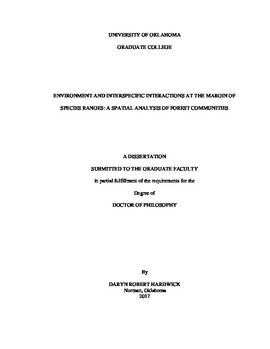| dc.description.abstract | Problem: Species’ geographic ranges are determined, in part, by suitable environmental conditions, the ability to reach sites possessing those environmental conditions, and the capability to survive interactions with other species until reproductive age. Species’ geographic ranges and community composition have been related to environmental conditions frequently, to dispersal limitation infrequently, and rarely to biotic interactions. This dissertation utilizes spatially explicit analysis to further elucidate the effect of geography on community composition, beta diversity, interspecific interactions, and the intersections of them on species’ geographic ranges. Contradictory evidence suggests that interspecific interactions become either more facilitative or competitive with increasing stress, however results appear to be affected by the scale of study. Therefore, I performed a regional scale study to analyze interspecific interactions across a regional stress gradient, the proximity to a species’ range margin.
Methods: Bottomland and upland forests consisting of 91 species across 307 sites were analyzed across spatial and environmental gradients. Sites were separated on the basis of species presence using a Nonmetric Multidimensional Scaling ordination and grouped using an agglomerative hierarchical clustering algorithm. To explain variance in community composition, climate, spatial, and edaphic variables were related to species presence across sites with a Redundancy Analysis ordination which uses multiple Canonical Correspondence Analyses. Species’ range margins were delineated using species occurrence data from the Forest Inventory and Analysis with MaxEnt modeling software. In order to test how interspecific interactions change across species’ ranges, a spatially explicit model assessing co-occurrence in groups of nearest neighbor sites was created using Python programming language. Interspecific interactions were subsequently compared to randomly generating communities.
Results: Species within site groups respond primarily to average annual precipitation and secondarily to the standard deviation in monthly precipitation. Sites are more aggregated in environmental space than physical space. Variation in community composition is best explained by climatic variables (22%) followed by spatial (9.9%) and edaphic (9.8%) variables. Beta diversity is significantly positively correlated with climate distance, mammal and bird beta diversity, the variance in distances to species’ range margins, and soil texture distance between sites. Net interspecific interactions monotonically shift from competitive to facilitative with proximity to species’ range margins. Species exhibit monotonic, unimodal, and multimodal relationships between net interaction intensity and proximity to their respective range margins in approximately equal proportions. As conditions become more favorable, species within a genus interact more competitively than species of different genera. Both locally rare and locally dominant species experience net competitive interactions, while locally common species experience net facilitative interactions. Regionally dominant species experience a greater intensity of net competitive interactions and do not experience net facilitative interactions across the stress gradient. Regionally rare species experience relatively net neutral interactions; however, they experience net facilitative interactions beyond their range margins. Net interactions in null communities are of higher competitive intensity regardless of proximity to range margins.
Significance: By discerning the effects of environment, space, and interspecific interactions on community composition, this dissertation serves to improve our understanding about the structure of species’ ranges. Projected climate change may force species to adapt to novel conditions or migrate to suitable habitat. Additionally, species will likely exist in communities consisting of different species assemblages. Modeling community composition is difficult since research on the change of biotic interactions through space and through species’ ranges is deficient. Analyzing the proximity to range margins as a surrogate for stress provides a spatial framework for utilizing biotic interactions in the modeling of species’ geographic ranges. For sessile organisms such as trees, dispersal of propagules is the primary method of shifting or expanding the species’ range. Facilitative interactions at shifting range margins may provide refuge for propagules facing stressful environmental conditions. Finally, results on how interactions affect species performance across their geographic range inform broader discussion of the species niche. I have provided spatial evidence that the realized niche of a species is expanded through net facilitative interactions beyond species’ range margins. Understanding the role of facilitative interactions at range margins may improve upon and direct conservation efforts for species at risk under projected climate change. | en_US |
